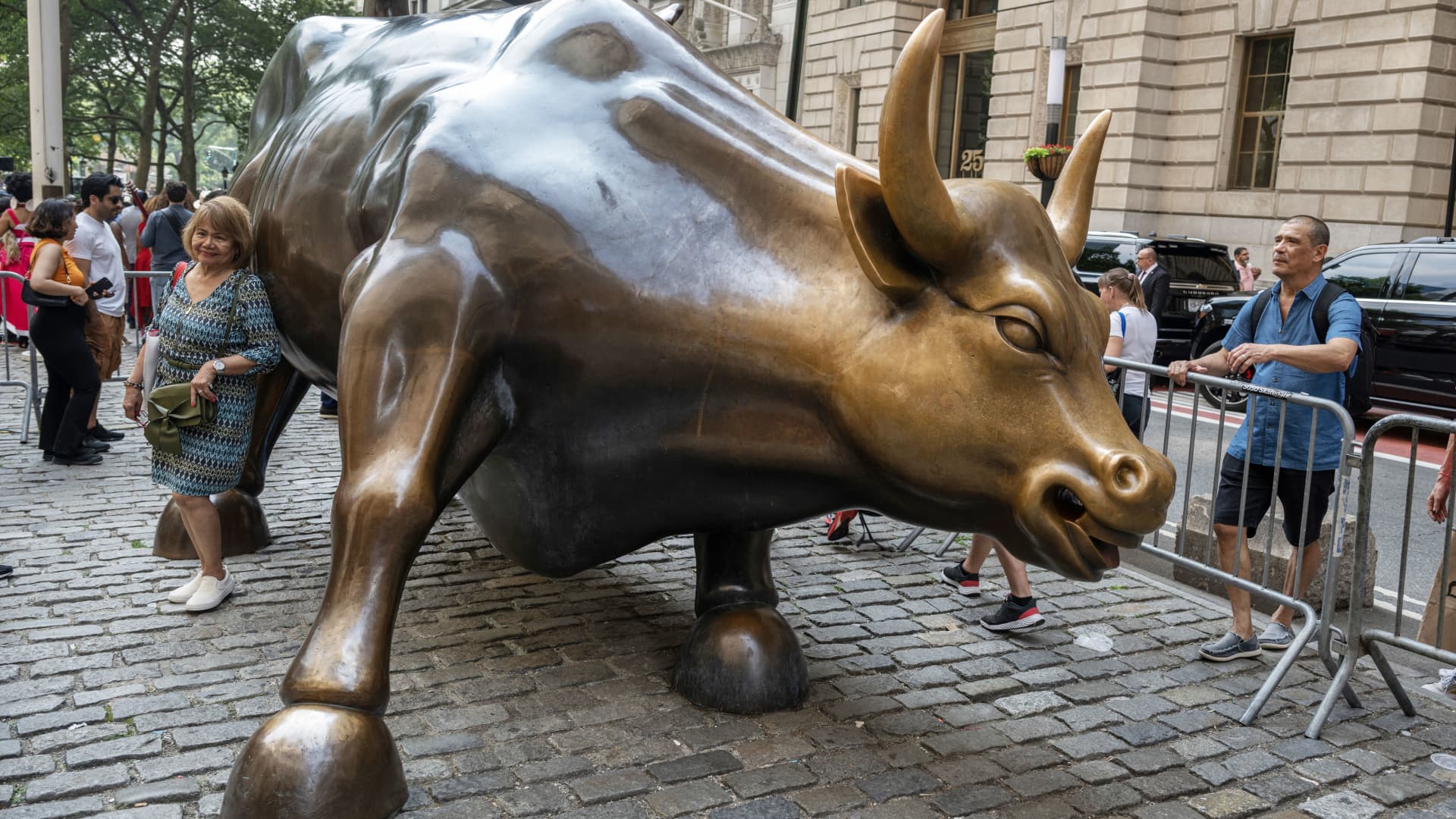[ad_1]
Visitors around the Charging Bull statue near the New York Stock Exchange, June 29, 2023.
Victor J. Blue | Bloomberg | Getty Images
The S&P 500 is up 14% this year, but just eight days explain most of the gains.
If you want a simple indication of why market timing is not an effective investment strategy, take a look at the S&P 500 year-to-date data.
DataTrek’s Nicholas Colas notes that there have only been 11 more days up than days this year (113 up, 102 down) and yet the S&P 500 is up 14% so far this year.
How do you explain that the S&P is up 14%, but the number of up days is about the same as the down days? Simply saying that there is a rally in big cap tech doesn’t quite do justice to what happened.
Colas notes that there are eight days that can explain the majority of the gains, all related to the biggest stories of the year: big tech, the banking crisis, interest rates/Federal Reserve, and avoiding a recession:
S&P 500: Biggest Gain This Year
- January 6 +2.3% (weak jobs report)
- April 27, +2.0% (META/Facebook shares rise on better-than-expected earnings)
- January 20, +1.9% (Netflix posts better-than-expected sub-growth in Q4, major tech rallies)
- November 2 +1.9% (10-year Treasury yields fall after Fed meeting)
- May 5 +1.8% (Apple gains strongly, banks rise after JP Morgan upgrade)
- March 16, +1.8% (consortium of major banks placed deposits with First Republic)
- March 14 +1.6% (banking regulators offered deposit guarantees at SVB and Signature Bank)
- March 3 +1.6% (interest rate on 10-year government bonds falls below 4%)
Source: DataTrek
The good news: These big issues (big cap tech, interest rates, avoiding a recession) “remain relevant now and are the most likely catalyst for a further rally in U.S. equity markets,” says Colas.
The bad news: If you hadn’t been in the markets for those eight days, your returns would have been significantly worse.
Why market timing doesn’t work
Colas illustrates a problem that has been known to stock researchers for decades: market timing – the idea that you can predict the future direction of stock prices and trade accordingly – is not a successful investment strategy.
Here Colas implies that if an investor had not been in the market on those eight best days, returns would have been very different.
This doesn’t just apply to 2023: it applies to every year.
In theory, putting money into the market when prices are falling, selling when they are higher, and buying when they are low again, in an infinite loop, is the perfect way to own stocks.
The problem is that no one has been able to consistently identify the tops and bottoms of the market, and the cost of not being in the market on the biggest days is devastating to a long-term portfolio.
In my book ‘Shut Up and Keep Talking: Lessons on Life and Investing from the Floor of the New York Stock Exchange’ I devote a chapter to why market timing doesn’t work.
Here is a hypothetical example of an investment in the S&P 500 over a 50-year period.
Hypothetical growth of $1,000 invested in the S&P 500 in 1970
(until August 2019)
- Total return $138,908
- Minus the best performing day $124,491
- Minus the best 5 days $90,171
- Minus best 15 days $52,246
- Minus best 25 days $32,763
Source: Dimensional Funds
These are astonishing statistics. Missing just one day – the best day – in the last 50 years means you’ll earn more than $14,000 less. That’s 10% less money – because you didn’t go to the market one day.
If you miss the best 15 days, you will have 35% less money.
You can demonstrate this with almost any year or time period. This obviously works in reverse: if you had not been in the market on the worst days, the returns would have been higher.
But no one knows when those days will occur.
Why is it so difficult to time the market? Because you have to be right twice: you have to be right when you go in and when you go out. The chances that you can make both decisions and beat the market are very slim.
This is why indexing and sticking to the markets has slowly gained followers over the past fifty years. The key to investing isn’t market timing: it’s consistent investing and understanding your own risk tolerance.







